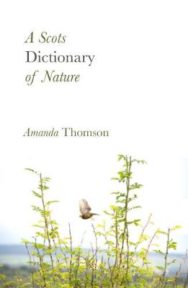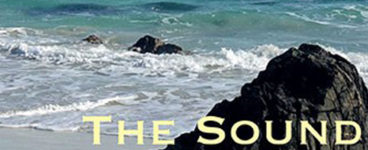‘Other words, however, might point to future ways of seeing the world, where we might take the time just to pause and look more, and see anew, or perhaps recognise familiar complications, joys and the elements of the world described differently. Perhaps to be around some of these words is to ‘cair’: to return to a place where one has been before.’
Artist Amanda Thomson curates and preserves for posterity those wonderful words of the Scots language relating to the world around us. It’s a joy to discover the deeply expressive vocabulary that has been used to describe land, wood, weather, birds, water and walking in Scotland.
Extract from A Scots Dictionary of Nature
by Amanda Thompson
Published by Saraband
This Scots Dictionary of Nature has been a long time in the making. As an artist, much of my work is about the Scottish Highlands, and in 2010, when I made an artist’s book called A Dictionary of Wood (which would be a first version of what you are reading now), I was doing research about the remnant Scots pinewood forests of Abernethy, and about Culbin, a Forestry Commission forest in Morayshire. Earlier that year, in a second-hand bookshop in Edinburgh, I had found an old Jamieson’s A Dictionary Of The Scottish Language, abridged by John Johnstone and published in 1846. The original price of £11 was embossed in gold on the spine, and I bought it for £20. In opening random pages, I’d come across words such as timmer breeks (timber trousers), meaning a coffin, and dedechack: the sound made by a woodworm in houses, so called from its clicking noise, and because vulgarly supposed to be a premonition of death.
I loved these words and more: they had a resonance and a particular feeling to them that was sometimes poignant and affecting, and sometimes conveyed a prosaic descriptiveness that nonetheless spoke of close connections and an attentiveness to the nuances of the landscape, what it contains, how we move through it, and even specific times of day or year. Break-back: the harvest moon, so called by the harvest labourers because of the additional work it entails. There were also words like huam: the moan of an owl in the warm days of summer, evocative of that feeling of the haziness of a long, hot summer’s day as it spills into evening. This old dictionary made me begin to wonder about lost connections to land and place and perhaps even ways of seeing and being in the world, and I began wondering what else I might find.
Eard-fast means a stone or boulder fixed firmly in the earth, or simply, deep rooted in the earth, and it’s a word that seems to get to the heart of this book. It resonates with ideas of place and belonging, makes me think of deep connections to places and particular landscapes and makes me consider how language can assist or be at the root of such connections.
Between 2009 and 2013 I was doing a doctorate and an element of my research related to the gradual changes that happen over time in the forests of Morayshire and Abernethy and how, when one is familiar with a place, one sees many more layers and begins to recognise the subtlest of these changes. I was also interested in how we make sense of and articulate our relationships to the land, both visually and verbally. As I walked with foresters and ecologists, I came across words like gralloch, used by a deerstalker to describe the innards of a dead deer (and the verb to gralloch, which so viscerally describes the task of removing them). Such words were unfamiliar to me, and yet foresters and ecologists used them with ease and specificity to describe their everyday activities. As I listened and heard these new (to me) words, they informed additional ways of seeing and gave me different understandings of the places where I was walking and of the activities they were carrying out. And there were other phrases too, some quirky, others pithy. An older forester told me about a man who started working for the Forestry Commission but was not very good at his job: he was not “wid material”, the forester said.
. . .
I’m not a lexicographer, a linguist, or a historian of the Scottish language, but as an artist I am interested in words and language and how we might describe our world. In mining these dictionaries, I’ve found words that are rarely heard, no longer in use or perhaps largely forgotten. These “found” words evidence a confluence of local and social histories, allude to changing ways of life and shifting connections, and point to fascinating relationships with nature and the land. Some show how land and nature permeate other aspects of our lives. The word flocht relates to birds and means on the wing, but then there’s to flochter, which means to give free scope to joyful feelings. Others give us immediate access to a language and a way of being in the world, being on and in the land, which may or may not be the same as now. While we see the same weather phenomena today, more or less, as when the Jamieson dictionary was published – over a century and a half ago – the impact and significance of particular kinds of weather is probably, for most of us, not the same. Naming denotes importance and significance, and the ability to notice angry teth (the fragment of a rainbow appearing on the horizon, and when seen on the north or east indicating bad weather), to recognise Banff-baillies (white, snowy-looking clouds on the horizon, betokening foul weather), or to observe that the day is lunkie (denoting the oppressive state of the atmosphere before rain or thunder) has very different implications for car drivers or city-dwellers than for someone out in a small fishing boat or for a farmer assessing whether the barley should be harvested.
A Scots Dictionary of Nature by Amanda Thompson is published by Saraband, priced £12.99.
ALSO IN THIS ISSUE

 A Scots Dictionary of Nature
A Scots Dictionary of Nature
‘Other words, however, might point to future ways of seeing the world, where we might take the time …














